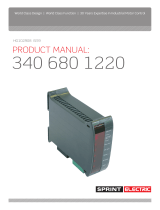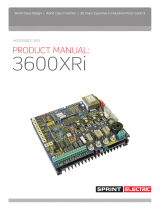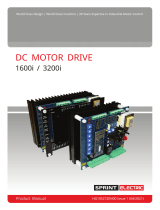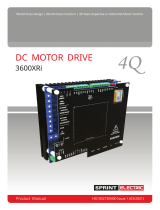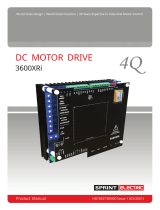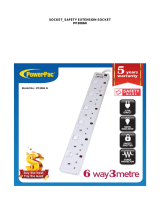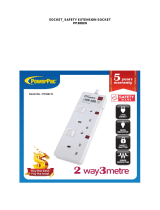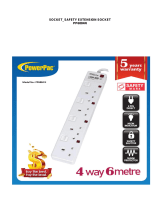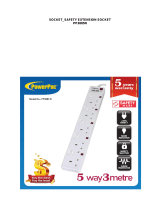Page is loading ...

World Class Design | World Class Function | 30 Years Expertise In Industrial Motor Control
HG103278 v6.00a
PRODUCT MANUAL:
PL/X DIGITAL DC DRIVE
PART 3: HIGH POWER MODULES SUPPLEMENT

PLX275 - 980 1
This manual should be read in conjunction with the PL / PLX Digital DC Drive Manual. (Part 1)
Important. See section 2 in main PL / PLX Digital DC Drive Manual for WARNINGS
1 Table of contents
1 Table of contents.......................................................................................... 1
2 Introduction ................................................................................................ 2
3 Rating Table................................................................................................ 2
4 Mechanical Dimensions PL/X 275 – 440................................................................ 3
5 Mechanical Dimensions PL/X 520 - 980................................................................ 4
6 Venting ...................................................................................................... 5
6.1 General venting information............................................................................................ 5
6.1.1
When venting kit impractical. Models PL/X 275/315/360/520/600............................................5
6.1.2
When venting kit impractical. Models PL/X 400/440/700/800/900/980......................................5
6.2
Venting kit for PL/X 275 - 440.......................................................................................... 5
6.2.1
PL/X 275 - 440 venting kit diagram ..................................................................................6
6.3
Venting kit for PL/X 520 - 980.......................................................................................... 6
6.4
Air supply to enclosure .................................................................................................. 7
6.5
Exhaust air .................................................................................................................. 7
6.6
Venting summary .......................................................................................................... 7
6.6.1 Diagram of air flow .....................................................................................................8
7 Product rating table ...................................................................................... 9
7.1
Product rating labels ..................................................................................................... 9
7.2
Semiconductor fuses.....................................................................................................10
7.2.1
PL and PLX Models AC and DC semiconductor fuses ............................................................ 10
7.2.2
PLX Models DC semi-conductor fuses .............................................................................. 11
7.3 Terminal information....................................................................................................11
7.3.1 Control Terminals ..................................................................................................... 11
7.3.2 Powerboard Terminals ............................................................................................... 11
7.3.3
Terminal tightening torques ........................................................................................ 11
7.3.4
Forces applied to the power terminals............................................................................ 11
7.3.5
Avoid dropping small objects into unit ............................................................................ 12
7.4
Line reactors ..............................................................................................................13
7.5
Lifting the unit ............................................................................................................13
7.5.1
Unit weight ............................................................................................................. 13

2 PL/X275 - 980
2 Introduction
These additional models have all the functionality as described in the PL / PLX Digital DC Drive Product Manual.
They also have the option of being supplied as MV units that are able to accept AC supply voltages up to 600 Volts
and HV units that are able to accept AC supply voltages up to 690 Volts for motors with armatures of 750V DC.
They are available with the power 3 phase supply terminals in standard top entry, or bottom entry as an option.
3 Rating Table
Nominal maximum continuous shaft ratings
Model
PL 2 quadrant
PLX 4 quadrant
Suffix MV for 600 VAC
Suffix HV for 690 VAC
Suffix BE for bottom
entry 3 phase power
kW
at
460V
olt
HP
at
460V
olt
HP
at 500V
HP
at 750V
(690V AC)
HV models
100%
Armature
Current
DC Amps
100%
Field
Amps
Dimensions mm
W x H x D
PL and PLX 275 275 370 400 600 650 32 or 50 253 x 700 x 350
PL and PLX 315 315 425 460 690 750 32 or 50 253 x 700 x 350
PL and PLX 360 360 485 520 780 850 32 or 50 253 x 700 x 350
PL* and PLX 400 400 540 580 875 950 32 or 50 253 x 700 x 350
PL*
<
and PLX
<
440 440 590 640 970 1050 32 or 50 253 x 700 x 350
PL and PLX 520 520 700 760 1140 1250 64 506 x 700 x 350
PL and PLX 600 600 810 880 1320 1450 64 506 x 700 x 350
PL* and PLX 700 700 940 1020 1530 1650 64 506 x 700 x 350
PL* and PLX 800 800
1080
1170 1760 1850 64 506 x 700 x 350
PL* and PLX 900 800
1200
1300 1950 2050 64 506 x 700 x 350
PL*
<
and PLX
<
980 980
1320
1430 2145 2250 64 506 x 700 x 350
* Starred models: (PL*) 2 Q models have electronic regen stopping. PL/X
<
Models have no overload capability.
Standard Models
Main 3 phase supply 50 - 60hz Any supply from 12 to 500V AC nominal +/- 10% (CE)
Auxiliary 3 phase supply 50 - 60hz Any supply from 100 to 500V AC nominal +/- 10% (CE)
Control 1 phase (50VA) 50 - 60Hz Any supply from 110 to 240V AC+/- 10%
Medium Voltage (MV) Models
Main 3 phase supply 50 - 60hz Any supply from 12 to 600V nominal AC +/- 10% (CE)
Auxiliary 3 phase supply 50 - 60hz Any supply from 100 to 690V nominal AC +/- 10% (CE)
Control 1 phase (50VA) 50 - 60Hz Any supply from 110 to 240V AC+/- 10%
High Voltage (HV) Models
Main 3 phase supply 50 - 60hz Any supply from 12 to 690V nominal AC +/- 10% (CE)
Auxiliary 3 phase supply 50 - 60hz Any supply from 100 to 690V nominal AC +/- 10% (CE)
Control 1 phase (50VA) 50 - 60Hz Any supply from 110 to 240V AC+/- 10%
Internal Fan supply
PL/X 275/315/360/400/440 models also need a separate 100VA 240V 50/60Hz ac supply for the fan.
PL/X 520/600/700/800/900/980 models also need a separate 200VA 240V 50/60Hz ac supply for the fan.
OUTPUT VOLTAGE RANGE
Armature PLX and PL* 0 to 1.2 times AC supply. PL 0 to 1.3 times AC supply. (Absolute upper limits)
Note. 1.1 times AC supply is recommended if supply variations exceed –6%.
Field 0 to 0.9 times AC supply on auxiliary terminals. (EL1, EL2, EL3)
OUTPUT CURRENT RANGE
Armature 0 to 100% continuous. 150% for 25 seconds +/- for PLX
Field programmable minimum to 100% continuous with fail alarm.
<
Note. Models PL440, PLX440, PL980, PLX980 have no overload capability.

PLX275 - 980 3
4 Mechanical Dimensions PL/X 275 – 440
Weight 45KG See 7.5 Lifting

4 PL/X275 - 980
5 Mechanical Dimensions PL/X 520 - 980
Weight 90KG. See 7.5 Lifting
High current
AC supply
terminals
High current
AC supply
terminals
Bottom
Entry option
DC Armature
terminals
Field Supply and
Output terminals
DC Armature
terminals
High current
AC supply
terminals
Bottom
Entry option

PLX275 - 980 5
6 Venting
6.1 General venting information
In order to keep these units within the required operating temperatures under all operating limits they are
equipped with a very efficient cooling system. It consists of a powerful centrifugal fan system integral to the unit
mounted at the bottom, which blows air over a high dissipation heatsink. Cool air is drawn in both at the top and
bottom of the unit and after travelling over the internal heatsink fins, is exhausted at the top of the unit. From
here the warm air must be vented from the enclosure used to house the drive.
See 4 Mechanical Dimensions PL/X 275 – 440 and 5 Mechanical Dimensions PL/X 520 - 980 for diagram of air
exhaust flow. The unit will run cooler and hence be less stressed if the warm exhaust air is prevented from
mixing with the intake air. This can be achieved by the use of the optional venting kit. See below.
6.1.1 When venting kit impractical. Models PL/X 275/315/360/520/600
For these models it is usually sufficient to ensure that the enclosure is fitted with exhaust fans that can evacuate
air from the enclosure at a rate at least as high as the drive fan, but within the capacity of the enclosure inlet
filter. See 3 Rating Table for airflow ratings. When fitting enclosure fans ensure they are placed in the roof of
the enclosure directly above the exhaust outlet of the PL/X.
6.1.2 When venting kit impractical. Models PL/X 400/440/700/800/900/980
For these models it is necessary to keep the exhaust air that is emitted from the top end of the fin section
seperated from the rest of the enclosure by constructing a duct that can evacuate the exhaust air from the
enclosure. If this requires an indirect route then you may need to use external fans to maintain the required
airflow. See 3 Rating Table for airflow ratings. Ensure against pollutants entering the port and you may need to
use a suitable grill if there is a danger of birds or vermin making it their home.
6.2 Venting kit for PL/X 275 - 440
The venting kit comprises two steel ducts which are designed to telescope together. Hence the duct length from
the top of the drive is adjustable between 270mm to 538mm. It consists of three main components.
1) A lower duct which fits within the side cheeks directly above the heatsink exhaust area.
This is secured with 2 M5 screws. See 4 Mechanical Dimensions PL/X 275 – 440 for fixing point drawing. The lower
duct is 270mm long from the top edge of the PL/X.
2) The upper duct, which fits over the lower duct section, to extend the total length of the assembly.
It has a series of M5 side holes to allow adjustment. Once the desired height is established the upper duct can be
screwed to the lower duct through the selected hole, one screw per side. The useful length of the extended duct
may be adjusted in steps of approx. 20mm from 270mm to 535mm. The duct must be inserted through a tight
fitting rectangular hole in the roof of the enclosure (hole size 100mm x 252mm) and protrude above it by 10-
20mm. Then the gap between the duct and the enclosure roof must be sealed (e.g. using tape or flexible filler)
to ensure that the exhaust air and pollutants cannot enter into the enclosure.
3) A cowl which is fixed on top of the enclosure to prevent pollutants from dropping into the outlet.
The cowl is supplied with 4 off 70mm mounting pillars, and 4 M6 holes must be drilled in the roof of the
enclosure, to allow the mounting pillars to be fixed such that the cowl is positioned centrally over the duct. The
cowl will overhang the duct by 70mm all the way round. If there is a danger of birds or vermin entering the
exhaust port then it is recommend that a suitable grille is added round the edge of the cowl.
130m
m
280m
m
Hole in enclosure roof
100mm x 252mm

6 PL/X275 - 980
6.2.1 PL/X 275 - 440 venting kit diagram
6.3 Venting kit for PL/X 520 - 980
The venting kit comprises a cowl and 2 pairs of steel ducts, each pair being designed to telescope together.
Hence the duct length from the top of the drive is adjustable between 270mm to 535mm. There is also an
enclosure roof cowl. Each pair is the same unit as described in 6.2 Venting kit for PL/X 275 - 440. There are 2
exhaust ports at the top of the PL/X and each pair of ducts is used with one of the ports. Please read section 5.2
for details about each pair.
The ducts must be inserted through a tight fitting rectangular hole in the roof of the enclosure (hole size 100mm
x 504mm) and protrude above it by 10-20mm. Then the gap between the duct and the roof must be sealed (e.g.
using tape or flexible filler) to ensure that the exhaust air and pollutants cannot enter into the enclosure. Also
the interface between each pair of ducts must be sealed at the top where it protrudes from the roof.
The cowl is fixed on top of the enclosure to prevent pollutants from dropping into the exhaust outlet of the
drive. The cowl is supplied with 6 off 50mm mounting pillars, and 6 M6 holes must be drilled in the roof of the
enclosure, to allow the mounting pillars to be fixed such that the cowl is positioned centrally over the duct. The
Upper duct
slides over
lower duct
Select fixing
hole to
attach
to lower duct
Upper/lower
duct fixing
hole. M5
Lower duct
fits within
exhaust port
of drive. It is
270mm long
Lower duct M5
fixing hole
aligns with hole
in drive side
cheek
Cowl mounted
on enclosure
roof using 70mm
pillars provided
The cowl must
be fitted with
this lip facing
forward to
direct exhaust
air away from
the air intakes.

PLX275 - 980 7
cowl will overhang the duct by 70mm all the way round. If there is a danger of birds or vermin entering the
exhaust port then it is recommend that a suitable grille is added round the edge of the cowl
6.4 Air supply to enclosure
It is essential that the enclosure which houses the PL/X is supplied with sufficient cool clean air to satisfy the
throughput requirements of the PL/X and any other devices within the enclosure. Do not forget that the current
carrying components associated with the drive will be dissipating a considerable amount of heat especially when
the system is running at full capacity.
The enclosure must be fitted with air filters suitable for the airbourne pollutants encountered within its
environment. Together they must have a rated throughput of sufficient capacity for all of the exhaust fans used
in the enclosure. If the PL/X is fitted with a venting kit and there is another exhaust fan also operating for
cooling other components it is essential that the auxiliary fan does not starve the PL/X of its air supply. This
should be avoided if the input filters have sufficient capacity. It is recommended that the PL/X is provided with
its own filters, and an enclosure partition used to isolate it from the influence of the rest of the enclosure
cooling arrangements.
There should be 2 filters for the PL/X. One to provide air to the lower input port, and one for the upper port.
The inlet filters should be fitted to the enclosure adjacent to the input ports at the lower and upper ends of the
unit to ensure that the air drawn in is close to where it is needed. The reason for using filters at the top and
bottom of the unit is because if only one filter is provided, then when the enclosure door is shut, the airpath
from top to bottom may become throttled if the door is close to the face of the unit.
6.5 Exhaust air
After leaving the enclosure containing the PL/X the heated exhaust air will need to be prevented from elevating
the ambient temperature of the room that is housing the enclosure by using sufficient ventilation. Alternatively
the supply of cooling air may be obtained from outside and ducted to the enclosure.
6.6 Venting summary
Ensure a clean un-interruptible supply of cool filtered air is available for the PL/X and that the exhaust air is
adequately and safely disposed of. Use the venting kit to keep the hot exhaust air separate from the cooling
input air within the enclosure. Ensure the cooling air is available at the top and bottom of the unit. The PL/X will
survive running at high ambient temperatures but possibly at the expense of its potential lifespan. Observe good
engineering practice and keep all the components within the enclosure as cool as possible, consistent with
avoiding condensation. For installations subjected to high ambient temperatures consider the use of air
conditioning to achieve these requirements.
130m
m
268m
m
268m
m
Hole in enclosure roof
100mm x 504mm

8 PL/X275 - 980
6.6.1 Diagram of air flow
This diagram shows a side view of a unit
in an enclosure. This is the recommended
method for arranging the flow of cooling
air. The fan in the PL/X will draw air into
the top and bottom air intakes of the
unit.
There are 2 air inlet filters mounted on
the door. One adjacent to the lower air
intake of the unit and the other adjacent
to the upper air intake of the unit.
The exhaust air is exiting the enclosure
via the venting kit assembly which is
shown with the cowl fitted on the roof of
the enclosure.
If this hot exhaust air is likely to raise the
temperature of the air being drawn in,
then further measures must be taken to
direct it away from the system.
Air Intake
IMPORTANT. Ensure 200mm area
top and bottom of drive for
unrestricted air entry.
Venting Kit
ensures
exhaust air
does not
mix with
input air.
Air Intake
Lift
Points
Air Intake
Air Intake

PLX275 - 980 9
7 Product rating table
Output power Model
PL 2Q
PLX 4Q
At
OP = 460V
380 -415AC
Kw HP
At
500V
480AC
HP
At
750V
690AC
HP
Max continuous
Current (AMPS)
AC IP DC OP
Max field DC
output Amps
std option
Line
reactor
type
Cooling air
flow and
dissipation
cfm watts
PL/X275 275 370 400 600 530 650 32 50 LR650
400 1700
PL/X315 315 425 460 690 615 750 32 50 LR750 400 2000
PL/X360 360 485 520 780 700 850 32 50 LR850
400 2300
PL/X400 400 540 580 875 780 950 32 50 LR950 400 2500
PL/X440 440 590 640 970 860 1050 32 50 LR1050
400 2800
PL/X520 520 700 760 1140 1025 1250 64 LR1250 800 3200
PL/X600 600 810 880 1320 1190 1450 64 LR1450 800 3700
PL/X700 700 940 1020 1530 1350 1650 64 LR1650 800 4200
PL/X800 800 1080 1170 1760 1520 1850 64 LR1850 800 4700
PL/X900 900 1200 1300 1950 1680 2050 64 LR2050 800 5200
PL/X980 980 1320 1430 2145 1845 2250 64 LR2250 800 5700
Important Notes
1) Only use UL fuses for installations complying with UL codes.
2) 2Q models PL400/440/700/800/900/980 have a regenerative stopping capability.
3) The EL1/2/3 connections require 3 auxiliary fuses, (max ratings 80A, I
2
t 5000).
Sprint part no. Fuse CH00880A. Fuseholder CP102071
When selecting alternative types the fuse current rating must typically be 1.25 X the field current rating of the
motor. Max ratings 80A, I
2
t 5000.
4) Please consider the total component dissipation within the enclosure when calculating the required air
throughput. This includes the fuses, line reactors and other sources of dissipation.
5) 400 Cubic feet per minute is approximately equivalent to 12 cubic metres per minute.
6) The output power rating shown is at the 100% rating of the drive and is the power available at the shaft for a
typical motor. The actual power available will depend on the efficiency of the motor.
7) The high power field output option is an extra cost option and needs to be specified at the time of order.
8) The 690V AC supply is an extra cost option and needs to be specified at the time of order. Suffix HV
9) The bottom entry AC supply option needs to be specified at the time of order. Suffix BE
10) Models PL/X 900/980 have maximum ambient temperature rating of 35C. Derate by 100 Amps for 40C.
11) Derate by 1% per Deg C for ambient temperatures above 40C up to 50C.
7.1 Product rating labels
The product rating labels are located on the unit under the upper end cap. The product serial number is unique
and can be used by the manufacturer to identify all ratings of the unit. The power ratings and model type are
also found here, along with any product standard labels applicable to the unit.

10 PL/X275 - 980
7.2 Semiconductor fuses
WARNING. All units must be protected by correctly rated semi-conductor fuses. Failure to do so will
invalidate warranty. For semi-conductor fuses please refer to supplier.
7.2.1 PL and PLX Models AC and DC semiconductor fuses
500V AC Table
Output Main Fuses Aux Fuses DC Fuses
Model DC Amps
I
2
t [A
2
s] PartNo
I
2
t [A
2
s]
PartNo Holder
Line Reactor
I
2
t [A
2
s] PartNo
PL/X275 650 210,000 CH103301
770 CH00850A CP102054
LR650 490,000 CH103303
PL/X315 750 300,000 CH103302
770 CH00850A CP102054
LR750 700,000 CH103304
PL/X360 850 490,000 CH103303
770 CH00850A CP102054
LR850 900,000 CH103305
PL/X400 950 700,000 CH103304
770 CH00850A CP102054
LR950 1260,000 CH103306
PL/X440 1050 900,000 CH103305
770 CH00850A CP102054
LR1050 1850,000 CH103307
PL/X520 1250 1260,000 CH103306
4650 CH008100 CP102054
LR1250 2500,000 CH103308
PL/X600 1450 1850,000 CH103307
4650 CH008100 CP102054
LR1450 1900,000 CH103309
PL/X700 1650 2500,000 CH103308
4650 CH008100 CP102054
LR1650 2800,000 CH103310
PL/X800 1850 1900,000 CH103309
4650 CH008100 CP102054
LR1850 3100,000 CH103467
PL/X900 2050 2800,000 CH103310
4650 CH008100 CP102054
LR2050 4400,000 CH103330
PL/X980 2250 3100,000 CH103467
4650 CH008100 CP102054
LR2250 6600,000 CH103469
600/690V AC Table
Output Main Fuses Aux Fuses DC Fuses
Model DC Amps
I
2
t [A
2
s] PartNo
I
2
t [A
2
s]
PartNo Holder
Line Reactor
I
2
t [A
2
s] PartNo
PL275MV/HV
650 210,000 CH103301
770 CH00850A CP102054
LR650HV
PL315MV/HV
750 300,000 CH103302
770 CH00850A CP102054
LR750HV
PL360MV/HV
850 490,000 CH103303
770 CH00850A CP102054
LR850HV
PL400MV/HV
950 700,000 CH103304
770 CH00850A CP102054
LR950HV
PL440MV/HV
1050 900,000 CH103305
770 CH00850A CP102054
LR1050HV
PL520MV/HV
1250 1260,000 CH103306
4650 CH008100 CP102054
LR1250HV
PL600MV/HV
1450 1850,000 CH103307
4650 CH008100 CP102054
LR1450HV
PL700MV/HV
1650 2500,000 CH103308
4650 CH008100 CP102054
LR1650HV
PL800MV/HV
1850 1900,000 CH103309
4650 CH008100 CP102054
LR1850HV
PL900MV/HV
2050 2800,000 CH103310
4650 CH008100 CP102054
LR2050HV
PL980MV/HV
2250 3100,000 CH103467
4650 CH008100 CP102054
LR2250HV
PLX275MV/HV
650 485,000 CH103341
770 CH00850A CP102054
LR650HV 1090,000 CH103343
PLX315MV/HV
750 640,000 CH103342
770 CH00850A CP102054
LR750HV 1440,000 CH103344
PLX360MV/HV
850 1090,000 CH103343
770 CH00850A CP102054
LR850HV 2130,000 CH103345
PLX400MV/HV
950 1440,000 CH103344
770 CH00850A CP102054
LR950HV 2430,000 CH103346
PLX440MV/HV
1050 2130,000 CH103345
770 CH00850A CP102054
LR1050HV 3080,000 CH103355
PLX520MV/HV
1250 2430,000 CH103346
4650 CH008100 CP102054
LR1250HV 4100,000 CH103348
PLX600MV/HV
1450 3080,000 CH103347
4650 CH008100 CP102054
LR1450HV 4400,000 CH103349
PLX700MV/HV
1650 4100,000 CH103348
4650 CH008100 CP102054
LR1650HV 5800,000 CH103350
PLX800MV/HV
1850 4400,000 CH103349
4650 CH008100 CP102054
LR1850HV 8500,000 CH103471
PLX900MV/HV
2050 5800,000 CH103350
4650 CH008100 CP102054
LR2050HV 9632,000 CH103360
PLX980MV/HV
2250 8500,000 CH103471
4650 CH008100 CP102054
LR2250HV 12,075,000
CH103472

PLX275 - 980 11
7.2.2 PLX Models DC semi-conductor fuses
For PLX units used in applications in which regeneration occurs for most or all of the time, it is recommended to
fit a DC side semi-conductor fuse. This will further protect the unit in the event of an un-sequenced power loss
when regeneration is taking place
Note. It is not normally necessary to use DC fuses with the PL Models but if required then these fuses can be
used. Example. A *PL model that allows regenerative stopping is employed on a site that suffers from a higher
than normal amount of power brown outs or blackouts.
See fuse table above
7.3 Terminal information
7.3.1 Control Terminals
See Part 1 main product manual for control terminal information section 3.3.3, 3.4 and 3.5.
7.3.2 Powerboard Terminals
Remove busbar cover plate to reveal powerboard terminals.
For terminals T41 to T53 refer to main manual Part 1 section 3.3.3, for power terminals section 3.3.2.
7.3.2.1 Fan supply input
Remove busbar cover plate to reveal powerboard terminals. The fan supply input terminals are located on the
lower left hand edge of the powerboard marked AC FAN SUPPLY B1 N, B2 L.
Internal Fan supply
PL/X 275/315/360/400/440 models need a separate 100VA 240V 50/6OHz ac supply for the fan.
PL/X 520/600/700/800/900/980 models need a separate 200VA 240V 50/6OHz ac supply for the fan.
Note. If the fan supply fails, or is not present on power up then a warning message HEATSINK OVERTEMP is
displayed on the front of the unit, and operation of the motor will be prevented. See also the main manual
section 8.1.11.13 for further details of this message related to actual overtemp events.
7.3.2.2 Field supply input and output
Remove busbar cover plate to reveal powerboard terminals
The terminals EL1 EL2 EL3 F+ F- are M6 stud types found on the bottom right hand corner of the powerboard.
Further information on utilising these terminals is in Section 4 Basic Application and Section 14.9 Wiring
instructions, in the main manual. Also section 3.3.2 for specification. See section 7 Product rating table, in this
Part 3.
7.3.3 Terminal tightening torques
Terminals Model Tightening torque
Terminals 1 to 100 PL/X 275-980 4 lb-in or 0.5 N-m
EL1 EL2 EL3 F+ F- PL/X 275-980 35 lb-in or 3.9 N-m
L1 L2 L3 A+ A- PL/X 275-980 242 lb-in or 27 N-m
Fan supply terminals PL/X 275-980 9 lb-in or 1.0 N-m
7.3.4 Forces applied to the power terminals
Avoid applying mechanical stress to the heavy current terminals L1/2/3 A+ A-. Please ensure that any cables or
busbars that are bolted to these terminals are supported within the enclosure. Do not rely on the drive terminals
to support the weight of the external connections.

12 PL/X275 - 980
Do not use the connecting bolt to hold the terminal and the connecting cable or busbar in alignment, otherwise,
if they have been levered into alignment prior to inserting the bolt, there will be a permanent stress on the
terminal. Always support the connection to the terminal such that the only purpose of the terminal bolt is to
tighten them together and not to maintain their relative position to each other. The respective holes in the
terminal and the connecting busbar should remain in alignment without the aid of the terminal bolt. Then you
can be sure that there is minimum stress on the drive terminal busbar.
When tightening the connecting bolts of the terminals L1/2/3 A+ A- please ensure that the busbar is not
subjected to a turning moment as the nut is torqued down. To do this always use two spanners, one on the bolt
head to provide a counter torque and one on the nut to provide tightening torque.
7.3.5 Avoid dropping small objects into unit
If the unit is in the horizontal plane then there is a danger that objects may be accidentally dropped into the air
intake grille when connecting the busbars to the terminals. Or when the unit is vertical, dropping washers into
the fin section at the top, or objects dropping through the upper air intake grill. As a precaution it is advised that
a temporary cover be utilised over these areas when working on the unit, e.g. a piece of cardboard. Do not
forget to remove the temporary cover prior to starting the unit. If anything is dropped into the unit then it may
interfere with the fan rotation.

PLX275 - 980 13
7.4 Line reactors
Only use UL certified line reactors for installations complying with UL codes. These line reactors are not
certified. Refer to supplier for certified alternatives.
Max continuous
Current (AMPS)
Line reactor
Type
500V AC
Supply
Line reactor
Type
600V AC
Supply
Line reactor
Type
690V AC
Supply
Model
PL 2Q
PLX 4Q
Input
AC
Output
DC
PL/X275 530 650 LR650 LR650HV LR650HV
PL/X315 615 750 LR750 LR750HV LR750HV
PL/X360 700 850 LR850 LR850HV LR850HV
PL/X400 780 950 LR950 LR950HV LR950HV
PL/X440 860 1050 LR1050 LR1050HV LR1050HV
PL/X520 1025 1250 LR1250 LR1250HV LR1250HV
PL/X600 1190 1450 LR1450 LR1450HV LR1450HV
PL/X700 1350 1650 LR1650 LR1650HV LR1650HV
PL/X800 1520 1850 LR1850 LR1850HV LR1850HV
PL/X900 1680 2050 LR2050 LR2050HV LR2050HV
PL/X980 1845 2250 LR2250 LR2250HV LR2250HV
To obtain line reactor dimensions please refer to supplier
7.5 Lifting the unit
Use the lifting points provided. There are lifting holes at each end of the unit. Attach a loop of suitable rope
(approx. 1.2m for PL/X275-440 and 1.5m for PL/X520-980) between the lifting holes at each side at the top end,
and a similar loop at the bottom end, to assist in lifting the unit out of its container. When lifting the unit keep it
in either the horizontal or vertical plane to avoid deforming the side cheeks at the lifting points. Use the top end
lifting loop to assist in presenting the unit onto the back panel. The fixing holes at the top of the unit are
designed with a keyhole shape to allow the unit to be initially hung on the securing bolts. These should be fixed
on the back panel prior to presenting the unit into the enclosure.
Alternatively a small fork lift may be employed if the wheel has access under the door of the enclosure. (It is
usually possible to have access for one fork from the side of a typical enclosure with the side panel removed). If
access can be gained this way then you will need to bolt some temporary wooden extensions to the lifting holes
at the bottom of the unit in order to stand the unit on the fork which will enter the enclosure).
7.5.1 Unit weight
The PL/X 275-440 weighs 45Kg. The PL/X 520-980 weighs 90Kg.

14 PL/X275 - 980
05/04/17 HG103278v600a

Find out more:
www.sprint-electric.com
Sprint Electric Ltd. Peregrine House, Ford Lane, Ford
Arundel, West Sussex, BN18 0DF United Kingdom
Tel: +44 (0)1243 558080
Fax: +44 (0)1243 558099
Email: [email protected]
/


